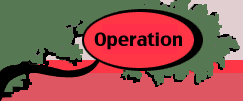| To construct a mathematical
model describing the economic costs or profits associated with
the inventory system, we show the cash flows below. This figure
is a mixed representation of discrete as well as continuous
cash flows. The arrows represent amounts paid or received at
points in time. The areas represent continuous cash flows given
by rates. Positive amounts are revenues, while negative amounts
are expenditures or costs. The blue area indicates revenues
from sales from the inventory. The revenue arrives continuously
during the early part of the cycle until the level reaches 0.
After this point in time, the lost sales cost is expended at
the rate equal to the demand rate. The red area represents holding
cost and the purple area represents the penalty due to lost
sales. The fixed setup cost A and the product cost
Cq are incurred at the beginning of each cycle. Note
that in this case the entire net profit (revenue less product
cost) for the entire demand is not received. With lost sales,
the lot size does not satisfy the entire demand unless the fill
rate is 1.
A single inventory cycle is shown below.
|
Since the demand is not entirely satisfied,
the fill rate is the lot size divided by the demand
during a cycle. The cycle time is a function of q
and v. The time when the inventory is exhausted
is t'.

|
The table below shows the various revenue and
cost components and their respective rates. The rates are the
cycle costs or revenues divided by the cycle time.
| Item |
Amount during a cycle |
Cost or revenue rate |
| |
A |
|
| Product Cost |
Cq |
|
| Holding Cost |
|
|
Lost Sales Cost |
|
|
Revenue from product Sales |
Rq |
RDv |
For this model there are two decision variables q
and v. We use the profit rate as a measure because
the entire demand is not met and the profit is reduced when
there are lost sales
Additional quantities associated with the inventory policy
are below.
When we compute the mean residence time for items held in inventory,
we use Little's Law with the flow rate through the inventory.
Backorder quantities are 0 since there are no backorders.
The measures are computed below for two examples using a lot
size of 400 units and a fill rate of 90%. The figure shows a
single cycle of the inventory pattern. The example assumes cost
and revenue for the product are both zero. The lost sales cost
includes both the lost profit and any additional charges associated
with the lost sale. The case in column N has the lost sales
cost of 2, while column O shows the case with a lower lost sales
cost of 1.2. The results are not markedly different. We will
see considerable difference when the optimum solutions are presented.
|



